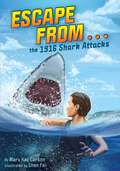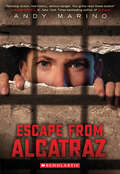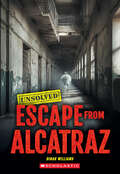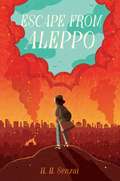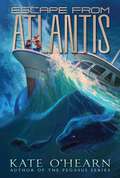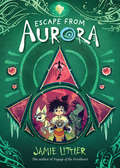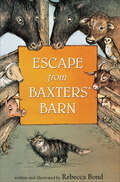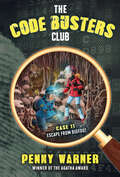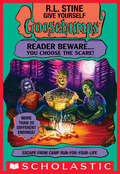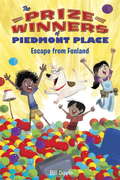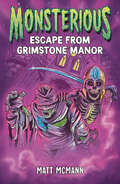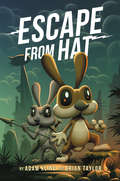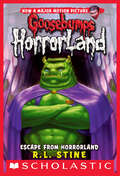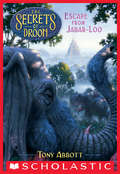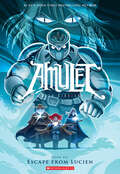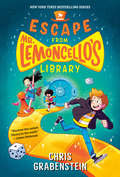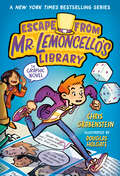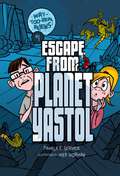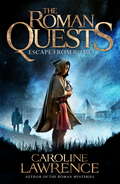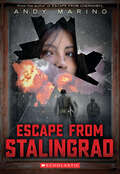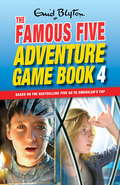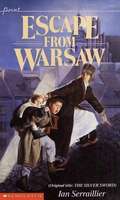- Table View
- List View
Escape from . . . the 1916 Shark Attacks (Escape From . . .)
by Mary Kay CarsonStay out of the water! During the summer of 1916, the "Jersey man-eater"-a great white shark-terrorized the coast of New Jersey. Based on real events, new friends Ed and Mike have to work together to survive one of the deadliest shark attacks in history!In the blistering summer of 1916, Ed Mitchell is melting in the heat wave boiling New York City. All the city pools are closed because of the polio epidemic, so Ed can't wait to flee to the Jersey Shore and cool off in the ocean. But during his first dip, a great white shark attacks a swimmer and sends the coastline into a panic. Ed is sent away from the shore to visit his aunt in Matawan, New Jersey, where he can stay safe and cool.In Matawan, Ed meets Mike Anders-a local boy who knows all the best spots in the nearby creek. Mike vows to teach Ed to swim, and Ed promises to help Mike read better. Little do they know, the new friends are about to have the summer of their lives.The "Jersey man-eater," the dangerous shark who keeps attacking swimmers, is headed right up the coast and into their favorite swimming spot! Will Ed and Mike be able to survive one of the deadliest shark attacks in history?
Escape from Alcatraz (Escape From)
by Andy Marino"Nonstop action, real history, serious danger. You gotta read these books!" -Alan Gratz, #1 New York Times bestselling author of RefugeeMay 1962In the middle of San Francisco Bay looms Alcatraz, home to America’s most infamous prisoners. Also home to Chip Carter and his dad, who works at the high security prison. Their neighbors are former mobsters, gangsters, and murderers, but Chip finds it to be a pretty boring place to live. After all, the inmates can’t hurt him--they’re locked up in an impenetrable fortress, surrounded by unforgiving waters.Or are they?Inmate AZ1441, aka the Watcher, has a plan to break out of Alcatraz. It’s a genius plan he’s concocted along with three other inmates. Foolproof. Or so he thought until one of the guard’s kids stumbles into the middle of it.Chip is stunned. No one can break out of the Rock. Not unless they have an inside guy. Which it seems like they do ... Chip’s dad. They know Chip’s onto them, so if he wants to survive, he’s going to have to make sure these men stay locked up. But first he has to figure out who is planning the prison break and just how deep into this deadly scheme his dad is. Because given what these men have done to end up in Alcatraz, there’s no telling what they’ll do to get out.
Escape from Alcatraz (Unsolved)
by Dinah WilliamsDid any prisoners ever escape Alcatraz? Discover the unsolved mystery in this beautifully illustrated book for kids, accessible for all readers!Alcatraz, once the world's most secure prison, is located on a small island in San Francisco Bay. Throughout its operation, many attempted to escape. In June 1962, three prisoners managed to break out, but they were never heard from again. What happened to them?Discover this unsolved mystery with real clues, facts, and pictures in the pages of this book. The story will unfold with easy-to-read text and exciting visuals. You can decide for yourself what you think happened during this mysterious escape from Alcatraz!ABOUT THIS SERIES:Take a deep dive into some of the most unbelievable but real unsolved mysteries from history. Is the Bermuda Triangle cursed? Do sea monsters exist? Can people just disappear? Each book in this series focuses on one unsolved mystery and describes its main events chronologically. Readers follow along as the exciting narrative uncovers real historical clues. Multiple theories are presented, providing an opportunity for readers to draw their own conclusions. The most up-to-date facts and relevant modern-day discoveries are included to allow for real-world connections. Perhaps you will be the one to solve an unsolved mystery!
Escape from Aleppo
by N. H. SenzaiAn Indie Next List Pick <p><p> Nadia’s family is forced to flee their home in Aleppo, Syria, when the Arab Spring sparks a civil war in this timely coming-of-age novel from award-winning author N.H. Senzai.Silver and gold balloons. <p><i>A birthday cake covered in pink roses. A new dress. </i> <p>Nadia stands at the center of attention in her parents’ elegant dining room. This is the best day of my life, she thinks. Everyone is about to sing “Happy Birthday,” when her uncle calls from the living room, “Baba, brothers, you need to see this.” Reluctantly, she follows her family into the other room. On TV, a reporter stands near an overturned vegetable cart on a dusty street. Beside it is a mound of smoldering ashes. The reporter explains that a vegetable vendor in the city of Tunis burned himself alive, protesting corrupt government officials who have been harassing his business. Nadia frowns. <p> It is December 17, 2010: Nadia’s twelfth birthday and the beginning of the Arab Spring. Soon anti-government protests erupt across the Middle East and, one by one, countries are thrown into turmoil. As civil war flares in Syria and bombs fall across Nadia’s home city of Aleppo, her family decides to flee to safety. Inspired by current events, this novel sheds light on the complicated situation in Syria that has led to an international refugee crisis, and tells the story of one girl’s journey to safety.
Escape from Atlantis (Atlantis #1)
by Kate O'HearnFrom the author of the Pegasus series comes a spellbinding first book in a new fantasy series for fans of Rick Riordan and Shannon Messenger following two cousins whose summer vacation gets swept away by a storm that lands them on the lost island of Atlantis.The last way that Riley Evans wanted to spend spring break was studying whales on the family sailboat in the middle of the Bermuda Triangle. With only her dad, aunt, and annoying cousin Alfie for company, she is so bored staring at the waves that she&’s starting to see mermaids between them. But when their boat is capsized during a sudden storm, Riley finds more excitement than she bargained for as she and Alfie are washed ashore with neither of their parents in sight. Where they&’ve been shipwrecked is no deserted island, though. Atlantis is a place beyond imagination, inhabited by both people and incredible creatures ranging from unicorns and gargoyles to talking animals. But not everyone welcomes the cousins&’ arrival, and beneath the wonder of this mythical land lurk dangerous secrets—something strange is happening to the inhabitants. What Riley wants more than anything is to find her father and go home. But the closer she gets to this goal, the more the islanders seem determined to keep her from reaching it. As Riley and Alfie unravel the mystery of Atlantis and its most terrifying part, the Forbidden Zone, they realize that the clock is ticking. If they can&’t learn what happened to their parents and find a way off the island soon, it may be too late to leave.
Escape from Aurora: Escape From Aurora
by Jamie LittlerNevermoor meets How to Train Your Dragon in the thrilling sequel to Voyage of the Frostheart!Ash and his ragtag crew of misfits aboard the Frostheart sleigh have just pulled into Aurora: the most dazzling city Ash has ever seen. Icy skyscrapers, wondrous new foods, and bustling city folk who barely have the time of day for a smalltown kid like him. That is, until he masters the art of songweaving--the ability control the giant monsters that lurk in the snow beyond city limits. But the real reason Ash came to Aurora is to find his long lost parents. The only token they left him before their disappearance was a lullaby; a map disguised as a song that has led him from landmark to landmark, all in the hopes of finding them at the end of it. With the help of his best friend Lunah, the fast-talking ship's navigator, and his yeti guardian, Tobu, Ash is one step closer to finding the family he's always longed for.He might find, though, that getting what you wished for is more complicated than he imagined, and Ash's world is about to expand in ways he never thought possible.
Escape from Baxters' Barn
by Rebecca BondWhen Burdock the barn cat sneaks into the Baxters’ farmhouse kitchen to hide behind a warm stove, he overhears a sinister plot that endangers all the animals on the farm. It’s up to him and his cacophonous cohorts to figure out how to bust out of the barn before it's too late. In this winning debut, readers will fall in love with the solitary cat, the self-effacing cow, the unstoppable pig, even a wayward she-owl—all brought to life with clever dialogue, poetic descriptions, and expressive black-and-white illustrations. This warm, lively read-aloud story about teamwork and friendship has the timeless appeal of a much-loved quilt.
Escape from Berlin
by Irene N. WattsGood-bye Marianne - As autumn turns toward winter in 1938 Berlin, life for Marianne Kohn, a young Jewish girl, begins to crumble. First there was the burning of the neighborhood shops. Then her father, a bookseller, must leave the family and go into hiding. No longer allowed to go to school or even sit in a café, Marianne's only comfort is her beloved mother. Remember Me - Young Marianne is one of the lucky ones. She has escaped on the first Kindertransport organized to take Jewish children out of Germany to safety in Britain. At first Marianne is desperate. Marianne speaks little English and is made to feel unwelcomed in her sponsor's home and, most of all, she misses her mother terribly. As the months pass, she realizes that she cannot control the circumstances around her. She must rely on herself if she is to survive. Finding Sophie - Sophie Mandel was only seven years old when she arrived in London on the first Kindertransport from Germany. She has grown up with a friend of her parents, a woman she calls Aunt Em, and despite the war and its deprivations, she has made a good life for herself in England with her foster mother. She has even stopped thinking about the parents she left behind. Now the war is over, and fourteen-year-old Sophie is faced with a terrible dilemma. Where does she belong?
Escape from Bigfoot (The Code Busters Club #11)
by Penny WarnerIt’s time for a field trip to Gold Country! Cody, Quinn, Luke, M.E., and Mika are the Code Busters—clever clue hunters with a passion for puzzles. The group of friends are excited to explore caves and learn about the gold rush, all while solving codes. But when Matt the Brat plays tricks on them and Cody starts seeing a mysterious figure with glowing red eyes, their field trip takes a turn. Will the Code Busters be able to figure out who the figure is and what it wants? And will they maybe even find Bigfoot?
Escape from Camp Run-For-Your-Life (Give Yourself Goosebumps #19)
by R. L. StineReader beware--you choose the scare! GIVE YOURSELF GOOSEBUMPS!Heads up! You're on your way to sports camp! If only Uncle Ed can find the place. He’s the lamest driver ever.A sign up ahead says CAMP RUNNING LEAF. Hey! That's not the name of the camp you signed up for! But Uncle Ed is already driving away. Oh, well. Running Leaf is a sports camp too. Isn't that why the campers call it Camp Run-For-Your-Life?You've got a choice of events. If you enter the athletic competition called the "Selection," you could be selected for a free trip... to be a slave on Plant Xentron! Yikes. Maybe you'd better choose the wilderness hike instead. Just look out for that mountain lion over there! Oh and try to steer clear of the Zombies with rotting limbs...The choice is yours in this scary GOOSEBUMPS adventure that's packed with over 20 super-spooky endings!
Escape from East Berlin
by Andy MarinoFrom the author of The Plot to Kill Hitler trilogy and Escape from Chernobyl comes another fast-paced, high-interest historical thriller, chronicling two daring attempts to cross the Berlin Wall, set decades apart.December, 1961 - Marta is a young girl who saw thirty miles of barbed wire appear across her city overnight, separating Berlin into West and East — with Marta’s home on the Communist Bloc-controlled eastern side.--January, 1989 - Now a spray-painted concrete monolith, the Berlin Wall bisects the city. Kurt, a young East Berliner, often wonders what those living on the other side must think of their unseen neighbors. Do they hate the people of East Germany as completely as Kurt has been instructed to hate them?--Inspired by real events, Escape from East Berlin tells two stories of daring bids for freedom from the Eastern Bloc, set decades apart and relayed in alternating perspectives. Triumph and tragedy intertwine in this examination of both the earliest and final days of the Berlin Wall.
Escape from Funland
by Bill DoyleThe humor and heart of Modern Family meets wacky contests in book two of this series, which asks: What could be more fun than a fun house? A local theme park called Funland is hosting a huge contest to turn one family’s home into the ultimate fun house. Who wouldn’t want a slide from the bedroom to the backyard, a bumper-car kitchen, or a ball pit for a living room? The Talaska family is eager to compete! And the stakes are high. Their house is falling apart, and they might have to move away from Piedmont Place forever. Cal knows that his family can win, but it won’t be easy. First he and his sister, Imo, need to win a competition at school. Then the whole family has to live at Funland and find a hidden object. Can they really search every corner of the park in just five days? There’s only one way to find out. Let the contest begin!
Escape from Grimstone Manor (Monsterious #1)
by Matt McMannThis series of terrifying tales that combine monsters + mysteries is perfect for fans of Goosebumps.&“Spine-chilling and creepy!&” —Max Brallier, #1 New York Times bestselling author of The Last Kids on EarthIn a mansion on a hill,lived a man no one could kill.Raised the dead with magic darkto rule the world and make his mark.Zari has always been fascinated by creepy stories about Hezekiah Crawly, the real-life inspiration behind her local amusement park's haunted house attraction, so she's thrilled when her friends Mateo and Taylor agree to go on the last ride of the day before the park closes.But when the ride breaks down, the three get trapped inside the haunted house for the night! As if that weren't scary enough, the kids stumble onto a hidden staircase leading to a dark, cobwebbed crypt that doesn't seem like part of the ride—and by the looks of it, they aren't alone down there. Is it possible the stories about Hezekiah Crawly and his monstrous experiments are true? And if so, can Zari, Mateo and Taylor make it through the night in one piece?
Escape from Hat
by Adam KlineGood and bad luck battle to control the world in this hilarious and enchanting illustrated middle grade novel about a lucky rabbit, an evil black cat, and one hapless boy caught between them, from award-wining screenwriter and debut author Adam Kline.We all have good luck and bad, courtesy of our very own lucky rabbits and bad-luck black cats. Most people never notice them.Cecil Bean certainly never noticed the villainous cat, Millikin, that lurked around every corner or his devoted rabbit, Leek, who was never far from his side. At least not until Millikin hatches a deliciously evil plan to vanish Leek into a magician’s hat, leaving Cecil with no good luck at all and stranding poor Leek in a world that no rabbit has ever escaped from. Leek and Cecil will do anything to find their way back to each other—even if it means facing enormous odds and seemingly insurmountable obstacles. To escape from Hat, Leek must sail across the Great Ink, travel beyond the Jungle Prime Evil, trek through the Grottos of Ill Repute, and enter the heart of all bad luck: the fortress of the black cats itself.All while Cecil heads out on an adventure of his own to find the hard-heartened magician, whose tricks seem to have turned Cecil’s life upside down.Gear up for adventure in this boisterously entertaining debut novel by award-winning screenwriter Adam Kline, with gorgeous, full-color illustrations throughout by Brian Taylor! Soon to be a major animated motion picture from Academy Award-nominated director (Kung Fu Panda, Little Prince) Mark Osborne.
Escape from HorrorLand (Goosebumps HorrorLand #11)
by R.L. StineIn this spinoff to the New York Times–bestselling Goosebumps series, a brother and sister go to a theme park on a rescue mission and become trapped there.When siblings Lizzie and Luke discover a bunch of kids are trapped in Horrorland, they head to the scary amusement park to help. But none of the kids trust Lizzie and Luke and soon everyone is traveling through a Hall of Mirrors, hoping to escape to a different park. But once inside Panic Park, are they really safe? Why are there no exits? What’s in the Tunnel of Hate? Have they been tricked again?
Escape from Jabar-Loo (The Secrets of Droon #30)
by Tony AbbottEric, Julie, Neal, and Keeah are on a rescue mission! Galen, Max, King Zello, and Queen Relna are being held prisoner in the forbidding forest of Jabar-Loo, and it's up to the kids to save them. But setting them free is easier said than done. For Jabar-Loo is a place of ancient, unfathomable magic, where even the closest friend can be mistaken for a deadly enemy. . . . -amazon.com
Escape from Lucien: A Graphic Novel (Amulet #6)
by Kazu KibuishiKazu Kibuishi's #1 NEW YORK TIMES bestselling series continues!Navin and his classmates journey to Lucien, a city ravaged by war and plagued by mysterious creatures, where they search for a beacon essential to their fight against the Elf King. Meanwhile, Emily heads back into the Void with Max, one of the Elf King's loyal followers, where she learns his darkest secrets. The stakes, for both Emily and Navin, are higher than ever.
Escape from Mr. Lemoncello's Library (Mr. Lemoncello's Library #1)
by Chris GrabensteinTHE START OF THE NEW YORK TIMES BESTSELLING SERIES WITH MORE THAN TWO MILLION COPIES SOLD! Can you escape from what James Patterson calls &“the coolest library in the world&”? Follow along and solve the clues in this interactive adventure! From the co-author of Murdle Jr.: Sleuths on the Loose…&“A worthy successor to the original madman puzzle-master himself, Willy Wonka.&” —Booklist, starred review When Kyle Keeley learns that the world&’s most famous game maker, Luigi Lemoncello, has designed the town&’s new library and is having an invitation-only lock-in on opening night, he&’s determined to be there! But the tricky part isn&’t getting into the library—it&’s getting out. Because when morning comes, the doors stay locked. Kyle and the other kids must catch every clue and solve every puzzle to find the hidden escape route!Enjoy bonus content in the back—extra puzzles, an author Q&A, and more!The Lemoncello books are laugh-out-loud, puzzle-packed must-reads for classrooms and homes across America. Look for the whole series!Mr. Lemoncello&’s Very First Game (the prequel)Escape from Mr. Lemoncello&’s Library (also available as a graphic novel)Mr. Lemoncello&’s Library Olympics (also coming soon as a graphic novel)Mr. Lemoncello&’s Great Library RaceMr. Lemoncello&’s All-Star Breakout GameMr. Lemoncello and the Titanium TicketMr. Lemoncello&’s Fantabulous Finale
Escape from Mr. Lemoncello's Library: The Graphic Novel (Mr. Lemoncello's Library)
by Chris GrabensteinThe BESTSELLING book is now a full color, fast packed GRAPHIC NOVEL!The Lemoncello books have spent over 100 Weeks on the New York Times Bestseller List and are on 44 State Award Lists!Find out if game loving Kyle Keeley can escape from what James Patterson calls "the coolest library in all the world" in this fun-filled graphic novel from the much-loved co-author of Treasure Hunters and the bestselling illustrator of Last Kid on Earth!★ "A worthy successor to . . . Willy Wonka." --Booklist, Starred ReviewWhen Kyle learns that the world's most famous game maker, Luigi Lemoncello, has designed the town's new library and is having an invitation-only lock-in on opening night, he's determined to be there! But the tricky part isn't getting into the library--it's getting out. Because when morning comes, the doors stay locked. Kyle and the other kids must solve every clue and figure out every secret puzzle to find the hidden escape route!Now a full color, fast packed graphic novel!
Escape from New Babylon (Left Behind: The Kids #22)
by Tim Lahaye Jerry B. Jenkins Chris FabrySuspicion mounts as Vicki and the others head for the schoolhouse with newcomer Chris Traickin. Though he says he is one of them, the kids wonder if they can trust him. In New Babylon, Judd and Nada must help a stranger leave the city undetected. Back at the schoolhouse, Mark and the others make a decision that could help many hurting people but could also endanger the Young Trib Force. Follow the kids as they search for new ways to help others know the truth.
Escape from Planet Yastol (Way-Too-Real Aliens #1)
by Pamela F. ServiceJosh Higgins loves to make up stories about other planets. At least he thought he was making them up. After Josh publishes his first book, sinister blue aliens visit Earth! Josh quickly learns that the worlds he wrote about in his stories are way too real. The outer space thugs take Josh and his kid sister Maggie all the way to the desert planet Yastol. And when Josh and Maggie refuse to aid the blue guys, a chase begins across Yastol's harsh landscape. Will the help of the planet's brave Prince Izor be enough to save Yastol from the bad blue aliens? Or will the planet's many dangers finish off Josh and Maggie first?
Escape from Rome: Book 1 (Roman Quests #1)
by Caroline LawrenceThe first in a brand new historical adventure series from million-copy-selling Caroline Lawrence, set in Roman Britain during the reign of the evil Emperor Domitian. <P><P>The year is AD 94. When the evil Emperor Domitian sends soldiers to seize his family's home in the middle of the night, twelve-year-old Juba must escape with his brother and sisters, and journey to distant Britannia on the edge of the known world. <P><P>His task: To avoid capture and death. His quest: To find a safe haven in Britain. <P><P>His destiny: To save the children. Brand new exciting Roman series from the bestselling author of THE ROMAN MYSTERIES, perfect for children studying at Key Stage 2. Historical locations featured in book 1 are Rome, Ostia, Londinium and Fishbourne.
Escape from Stalingrad
by Andy MarinoFrom the author of Escape from Chernobyl comes another fast-paced historical thriller about a city caught between an enemy army and their own brutal government.Artem lives in the sleepy city of Stalingrad, which has mostly been cut off from war with Nazi Germany—until the summer of 1942. That July, martial law is declared as the Nazis begin their unprecedented march toward the city. Artem’s older brother is a soldier in Stalin’s Red Army, so Artem is worried for his brother’s safety once he and his family have evacuated the city.Then the announcement comes. Stalin has ordered that no civilians be allowed to leave Stalingrad. The city which bears his name is an important symbol, and the Red Army believe that the soldiers defending it will fight all the harder if their families’ lives are at stake.Artem and his new friend Yuna are put to work shoring up the city’s defenses, digging trenches and building fortifications. Then, on August 23rd, the bombing begins. A massive German air raid reduces most of the city to rubble. With Stalingrad blockaded by both the Germans and their own government, escape from the coming battle seems all but impossible…
Escape from Underground: Book 4
by Enid BlytonJulian, Dick, Anne, George and Timmy the dog find excitement and adventure wherever they go in Enid Blyton's most popular series. Join the Famous Five on their fourth adventure as they stay at the big, old house called Smuggler's Top - and choose for yourself how the mystery ends.Help the Five navigate the secret passages. Will you discover who else is using the secret ways, or get lost down a false trail? This exciting game story is based on Enid Blyton's Five Go To Smuggler's Top. The text in this edition has been sensitively edited for today's reader and is unillustrated.
Escape from Warsaw
by Ian SerraillierHistorical fiction. In Warsaw in 1942, the Balicki chidren watch in horror as Nazi Storm Troopers arrest their mother. With the war raging around them, they live in constant fear.
